Parkinsonia aculeata, Jerusalem Thorn
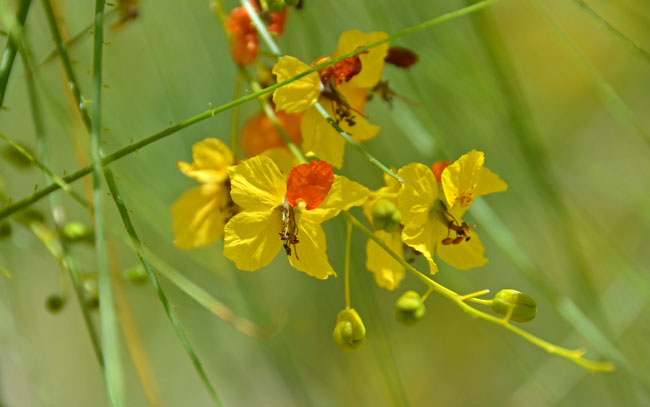
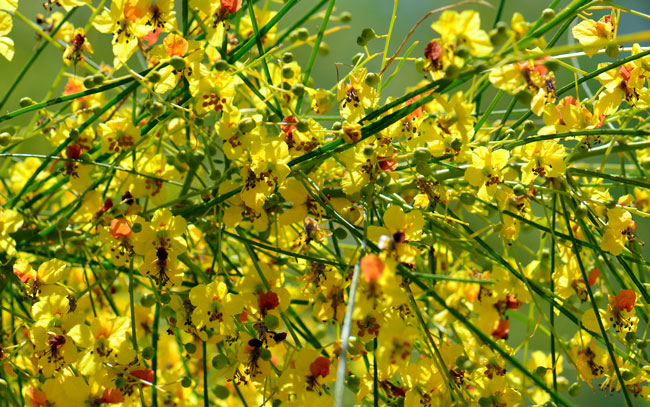
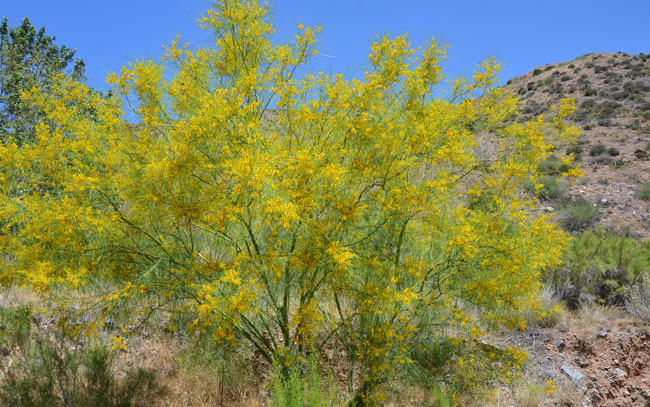
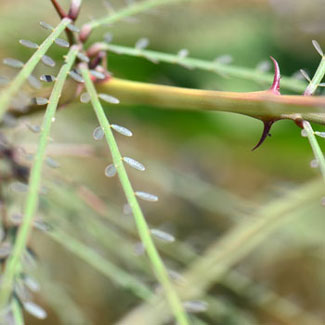
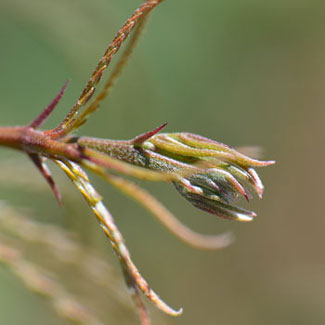
Scientific Name: Parkinsonia aculeata
Common Name: Jerusalem Thorn
Also Called: Horse Bean, Horsebean, Jerusalem-thorn, Mexican Palo Verde, Paloverde, Retama (Spanish: Guacaporo, Retama, Bagote,Lluvia De Oro, Huacapori, Junco Marino, Palo ver, Cacaporo, Guacóporo, Huacóporo, Espinillo, Mezquite Verde)
Family: Fabaceae or Leguminosae Family
Synonyms: ()
Status: Native
Duration: Perennial
Size: Up to 39 feet (12 m) and almost as wide, much smaller in habitat.
Growth Form: Jerusalem Thorn is a relatively small tree or multi trunk shrub; plants have spines as common with many desert dwelling trees; the branches are bright green or yellow-green and the smooth green bark is capable of photosynthesizing its own energy.
Leaves: Jerusalem Thorn trees have green leaves arranged alternately along the green stems; the leaves are pinnately compound; the small leaflets are in 1 to 3 pairs.
Flower Color: Jerusalem Thorn trees have bright yellow flowers that quickly fad to orange; the flowers are showy 1 inch (2.5 cm) wide with 5-petals; the bottom banner or standard petal may be diagnostic with its red or with red splotches; the fruit is a legume that splits open (dehiscent).
Flowering Season: March and May; with minor flowering throughout the year particularly following monsoon rainfall; April to October in California.
Elevation: 2,000 to 4,500 feet (610 - 1,372 m) throughout its' entire range; below 2,625 feet (800 m) in California.
Habitat Preferences: Commonly found in arroyos and low desert areas where water regularly drains; in certain other areas there may be found in sandy soils along washes; they are often found in limestone soils in Texas.
Recorded Range: In the United States Jerusalem Thorn is found primarily in the border states in AL, AZ, CA, FL, GA, HI, LA, MS, NM, NV, SC, TX and UT. It is also native to Baja California, Mexico and northern South America. In Arizona, Jerusalem Thorn is found in central and southern Arizona.
North America & US County Distribution Map for Parkinsonia aculeata.
North America species range map for Parkinsonia aculeata:
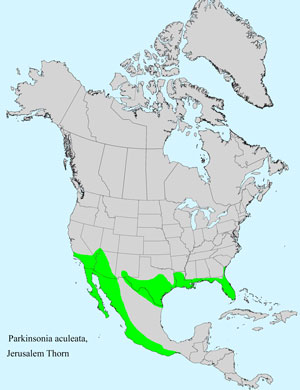
Invasive/Noxious Weed Information: Unknown
Threatened/Endangered Information:Unknown
U.S. Wetland Indicator: In North America Parkinsonia aculeata has the following wetland designations:
FAC = Facultative, occur in wetlands and non-wetlands
FACU = Facultative Upland, usually occur in non-wetlands, but may occur in wetlands. U.S. Weed Information: Unknown
International Invasive/Noxious Weed Information: 1The Centre for Agriculture and Bioscience International, (CABI), and 2The Invasive Species Compendium (ISC) has identified Parkinsonia aculeata as an “Invasive Species, Pest and Host Plant”.
This is one of the most widespread and well-known woody weeds in hot regions, and has become naturalized and shown weedy tendencies in all countries where it exists, whether native or introduced. It is disliked for its thorns, forming dense impenetrable thickets that degrade pasture, choke waterways and prevent cattle reaching water. It was often introduced as a fodder, hedging or ornamental tree, with an ability to tolerate the driest and most saline sites and water logging, but prolific seeding led to rapid spread. It is a prohibited weed in Australia and a serious pest in parts of other countries such as tropical Africa, Hawaii, and other Islands in the Pacific Ocean.
1The Centre for Agriculture and Bioscience International (CABI), Wallingford, Oxfordshire, England; The US Department of Agriculture is a lead partner with CABI.
2The Invasive Species Compendium (ISC) is an encyclopedic resource that brings together a wide range of different types of science-based information to support decision-making in invasive species management worldwide.
Genus Information: In North America, USDA Plants Database lists 4 species and 6 accepted taxa overall for Parkinsonia. Worldwide, World Flora Online includes 13 accepted species names for Parkinsonia.
The genus Parkinsonia was published in 1752 by Carl Linnaeus, (1707-1778).In the Southwestern United States: Arizona, California and Texas each have 3 species of Parkinsonia, Nevada has 2 species and New Mexico and Utah each have 1 species. Data approximate, subject to revision.
Comments: Jerusalem Thorn is a widely cultivated species in warmer areas. Occurrence of this species as “native” in central Arizona is likely more of an escapee from cultivation as opposed to a true native. It is easy to grow as its seeds are quick to sprout without additional preparation. This species thrives in poor alkaline soil. New lush growth is much more attractive than old growth.
Key distinguishing features that are generally, not always accurate separating 3 similar species of local Paloverde trees is the color of the large banner or standard petal as follows;
The species epithet “aculeata” means prickly.
The species epithet “Jerusalem Thorn” is from the Spanish and Portuguese word “girasol” which translated means “turning toward the sun”.
See complete listing of ethno-botanical uses at Native American Ethnobotany, University of Michigan, Dearborn.

